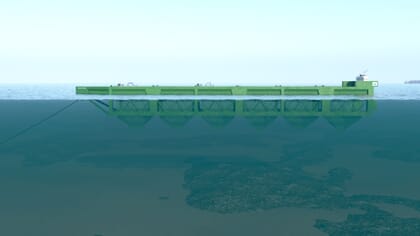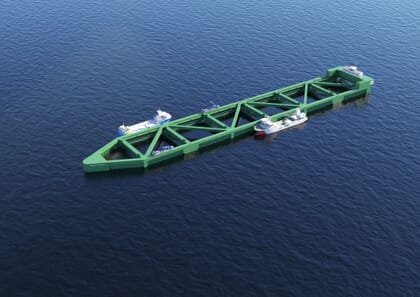The system, known as the Havfarm, is being developed by Nordlaks and NSK Ship Design, and is now a step closer to creation, after the recent decision by Norway’s Directorate of Fisheries to award additional development licences to the companies to help bring about the innovative farming system – after the companies appealed, following the directorate’s original decision to award only 10 of the 39 licences originally applied for.

© Nordlaks
Thirteen of the licences will be used to develop a stationary, vessel shaped system, while the remainder are being put aside for a mobile version of a similar design.
“The three extra licenses for Havfarm 1 are crucial to be able to test the concept to its full capacity,” Bjarne Johansen, project manager for the farming system, explains to The Fish Site. “The eight additional licences are crucial for us to be able to develop the dynamic Havfarm, which will allow us to operate in even more exposed areas.”
“The first Havfarm is a major step in exploring new areas for aquaculture, but with the second Havfarm we will be able to farm fish in almost every part of our exposed coastal zone,” he adds.
While the initial location for the mobile version has not yet been decided, the fixed equivalent will be placed in a location that’s close to Nordlaks’s existing operations hub, in Vesterålen.
“The first Havfarm will be placed outside of Hadseløya, which is close to Stokmarknes where we have our slaughtering facilities,” says Johansen.
“The second one will be dynamic and can be moved from different locations. We have not yet started to apply for any locations for the second Havfarm, this due to the fact that the decision from the Ministry of Fisheries is very fresh and the Directorate of Fisheries earlier approved Havfarm 1 with limitations. Therefore, we have focused our project development on Havfarm 1 so far,” he adds.
The initial system will have the capacity to grow 10,000 tonnes of salmon per cycle – which would mark a significant production increase for the company, which harvested 43,000 tonnes in 2016.
“Havfarm 1 will have a total capacity of 10,000 tonnes (13 licenses of 780 tonnes),” says Johansen. “For the second Havfarm, we are awaiting the final decision for the Directorate of Fisheries on the criteria for this part of the project.”
The “Nordlaks model”
The Havfarms will be part of a totally new production strategy that the company is developing. “Our new production strategy, called the Nordlaks model, will be based on three steps,” explains Johansen. “In the first stage we will grow post-smolts up to 250-300g in onshore facilities, for 12-14 months; in the second we will grow the salmon up to 1-1.5 kg in our existing sites (over 4-10 months); while the final growing stage (of 8-10 months) will be in the Havfarms.”
A number of considerations will need to be taken into account to ensure the health and welfare of the salmon in high energy locations.
“Fish welfare is a very important factor for us, and we have to make sure that the fish is strong enough to stand the natural conditions in open sea – with rougher waves and currents,” says Johansen.

The construction of the project, which is forecast to require investments of around NOK 2 billion (£200 million) before the first two Havfarms are complete, is pencilled in to start early next year.
“We have not yet decided where to build, but we hope to land a contract with a yard in the beginning of 2018,” says Johansen, “and to stock the first fish in the spring of 2020. For the second Havfarm it is a little too early to say.”


